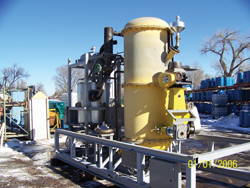
Features
Applications
Poultry
Process converts poultry litter into bio-oil
March 7, 2008 by Lori Greiner
Provides a safer and more environmentally acceptable solution to waste disposal.

|
| A researcher at Virginia Tech is working with poultry growers to test technology that would convert poultry litter to three value-added byproducts – pyrodiesel (bio-oil), producer gas, and fertilizer. This is an example of a pyrolysis unit, which can heat poultry litter until it vaporizes. The vapor is condensed within the unit to produce the bio-oil, and a slow release fertilizer is recovered from the reactor. The gas can then be used to operate the pyrolysis unit, making it a self-sufficient system. |
Dr. Foster Agblevor, associate professor of biological systems engineering at Virginia Tech, is leading the team of researchers in the College of Agriculture and Life Sciences developing transportable pyrolysis units that will convert poultry litter into bio-oil, providing an economical disposal system while reducing environmental effects and biosecurity issues.
Dr. Agblevor recently present a paper – Thermochemical conversion: A dual tool for bio-oil production and a solution to environmental waste disposal – as part of a session entitled “Characterization of Fossil and Biofuels: Challenges and Progress” held during the 234th American Chemical Society National Meeting in Boston during mid-August.
Dr. Agblevor is working with poultry growers to test technology that would convert poultry litter to three value-added byproducts – pyrodiesel (bio-oil), producer gas, and fertilizer. The pyrolysis unit heats the litter until it vaporizes. The vapor is then condensed to produce the bio-oil, and a slow release fertilizer is recovered from the reactor. The gas can then be used to operate the pyrolysis unit, making it a self-sufficient system.
More than 5.6 million tons of poultry litter is produced each year in the U.S. The litter consists of a mixture of bedding, manure, feathers, and spilled feed. According to Dr. Agblevor, current disposal methods, such as land application and feeding to cattle, are under pressure because of pollution of water resources due to leaching and runoff and concern about mad cow disease contamination in the food chain. There are also concerns that poultry litter can harbor diseases, such as avian influenza. While avian influenza is not harmful to humans, people can spread it on their shoes, with their vehicles, or through movement of litter.
“The self-contained transportable pyrolsis unit will allow poultry producers to process the litter on site rather than having to haul the litter to a separate location,” Dr. Agblevor said. “In addition, the thermochemical process destroys the microorganisms reducing the likelihood of the transmission of disease to other locations.”
Poultry litter sourced from broiler chicken and turkey operations as well as bedding materials (wood shavings or peanut hulls) were converted into bio-oils in a fast pyrolysis fluidized bed reactor.
According to Dr. Agblevor, bio-oil yields ranged from 30 to 50 percent by weight, depending on the age and the bedding content of the litter. Bedding material that was mostly hardwood shavings yielded bio-oil as high as 62 percent by weight. The higher heating value of the poultry litter bio-oil ranged from 26 to 29 mega joules per kilogram while bio-oil from bedding material was only 24 mega joules per kilogram. The bio-oils had relatively high nitrogen content ranging from four percent to seven percent by weight, very low sulfur content – below one percent by weight – and was very viscous. The char yield ranged from 30 percent to 50 percent by weight, depending on the source, age, and composition of the poultry litter. The char also had high ash content, ranging from 30 percent to 60 percent by weight, depending on the age and source of litter.

|
| Dr. Foster Agblevor, associate professor of biological systems engineering at Virginia Tech, is leading the team of researchers developing transportable pyrolysis units that will convert poultry litter into bio-oil, providing an economical disposal system while reducing environmental effects and biosecurity issues. |
“The type of poultry litter used will affect the amount and quality of the bio-oil produced and ultimately will impact the producer’s profitability,” Dr. Agblevor said. “Finding the right set of conditions for the poultry litter is key to the adaptation of this technology.”
This research is part of a concentrated effort by Virginia Tech researchers, Virginia Cooperative Extension specialists and agents, conservation organizations, state agencies, and private industry to determine the most effective means to support the agricultural community and manage the excess nutrients in the Shenandoah Valley. The research is being funded by a $1 million grant from the National Fish and Wildlife Foundation’s Chesapeake Bay Targeted Watershed Program.
In addition to Dr. Agblevor, co-authors from Virginia Tech’s Department of Biological Systems Engineering include Dr. Sedat Beis, postdoctoral associate; Dr. Seung-Soo-Kim, former postdoctoral associate (currently at the Korea Institute of Petroleum Quality); Ryan Tarrant, graduate student; and Ofei Mante, graduate student.